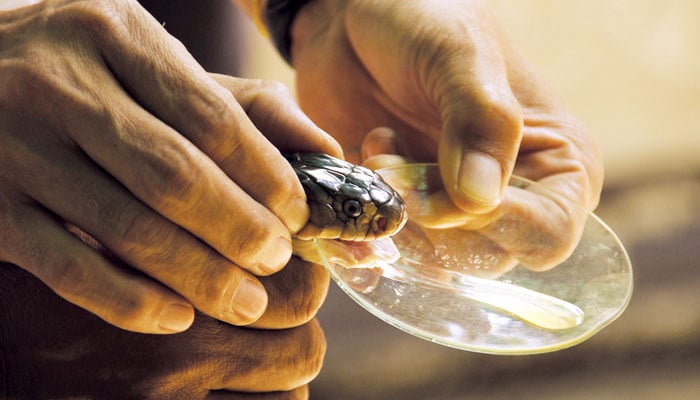Asian and African countries are considered to have the highest number of deaths due to snake bites worldwide. These two together form the largest land area in the world. These two continents consist of one hundred and forty-seven countries and contain all kinds of mountain systems, plateaus, plains, deserts, fresh and salt water. This is the reason why most of the animals found in the world have made their habitat in this region. A large number of venomous snakes are also spread over these two continents.
Although they are geographically the same species, they have some differences in the level of components in their venom. This difference becomes problematic when a human is given an antidote for a snake bite or an antivenom. This is because the medicine is actually made using horses and in this process the horses are given very small amounts of snake venom, then the amount is very carefully increased over time. And the horse, through its blood purification system, makes antibodies, which are a type of protein, to neutralize the effect of the poison.
This antibody is isolated from the blood of a horse to make an antidote to snake venom. Here it is very important to know who is using this medicine. What region does the snake belong to and has the antidote been made by using several venoms together, which we call Ksheer Gripta, or has this been done by using the venom of a single snake, which we call single gripta? These antidotes can neutralize the effect of snake venom in the area where the snake is found.
However, it has been observed that when the antidote made in one country is used in another country, it has some side effects and the patient needs a higher dose. The antidote used in Pakistan and other countries is usually multivalent, one reason being that if a patient has been bitten by a snake, it is a bit difficult to detect, as the snake would have been seen only by the patient. Or anyone who has seen it cannot tell correctly due to lack of knowledge about the types of snakes.
A doctor can usually make a guess based on a patient’s initial symptoms, but cannot determine with complete confidence. Therefore, a multivalent antidote is injected into the patient’s body. The condition of the patient and how much poison has entered the patient’s body determine how much of the antidote should be given at intervals. In addition, it also happens that a patient develops sensitivity or allergy due to overdosing, which becomes an additional burden of treatment.
Nevertheless, horse-made antidote is the most widely available in the world and is used for snake bites. Monkeys, rabbits, etc., have also been used for making antidotes, but despite the abundant availability and use of small amounts of snake venom, these small animals die during the process, whereas the horse is a robust animal. A lesser venom bears the brunt and its blood produces an antidote in the form of antibodies, but it is now clear that snakes of the same species vary regionally in the composition of their venom. . That is why we should take the venom of the snake of each region and make its specific antidote.
Although horse-derived blood is abundant and the antidote can be administered to a large number of patients, the cost to the horses and the need for a complete system to maintain the process for years are significant. Which is difficult for developing countries to maintain, then maintaining the quality of the obtained antidote is another important step, which is quality control.
All this scenario suggests that some other method should be adopted to make an antidote for snake venom, like the various vaccines available today which are made in the laboratory or insulin which is a is a hormone and is manufactured and sold as such on a commercial basis. Similarly antidote should be available at affordable prices.
In this regard, work has been done in various research institutes and efforts have been made to find a method which would not only make the preparation of the antidote easy but also make the drug available at low cost and have a highly useful formula free from side effects. be One strategy might be to collect venom from a single species of snake in a large area and then identify and isolate the most lethal component of that venom. This should be done with the snake venom of each area. Similarly, very few components but the most lethal part of the poison can be collected. This part will not be as complicated as raw poison.
Therefore, the most lethal components can be separated from other species of regional snakes in the same way and mixed with the parts of two different species of snakes, this compound can be used to make an antidote. The resulting antidote would be highly effective and relatively free of side effects, since the antidote would contain some lethal component of the venom of one or two different species of snakes from all regions. Therefore, this antidote can be used for all the surrounding countries and Bur-e-Azam.
This work has been published in an international journal based on preliminary research findings, authored by Atna Bana Ngkun, a research institute affiliated with Bangkok, Thailand. Similarly, another study published by Roman Ramosi and his colleagues points to another approach. Thanks to modern methods, it is now possible to obtain a thorough knowledge of any snake’s venom and identify the four or five most lethal toxins in the venom, and then start working with them. should be done
By exploiting the antibody that is formed as a result of interaction with these toxins, through specific epitopes, relatively small proteins can be obtained in the laboratory from specific cells that neutralize the effect of these toxins. Is. These antidote proteins can act as an antidote to the venom of the snake from which they are made, then another factor that, if used genetically, can also act as a form of immunization. May be available for treatment. However, it is clear that each method of making an antidote has its advantages and disadvantages. New and viable methods are emerging through technology. The NIH Institute in Pakistan is developing an antidote for snakebite.
This antidote is being made by horses in a multi-dose form. Thousands of people die from snake bites in Pakistan every year. According to an estimate, more than 8,000 people die out of 40,000 snakebite accidents. It has also been observed that the antidote produced in Pakistan and its quantity is insufficient to support such burden.
This is the reason why there is an antidote imported from abroad in Pakistan, which is less effective, because it is made from the venom of snakes found in other countries and despite the species being the same, there is nothing in the venom due to regional differences. There is some variation and that variation leads the snakebite patient in Pakistan to side effects and to require higher doses of imported antidote.
There is research on venomous snakes in Pakistan, but there is no research on its antidote. The result is that the antidote is being manufactured using the same horse-drawn method which is a financial burden for the antidote manufacturers. In addition to NIH, Dow University is also trying to do this. This scenario of our country is drawing attention to the fact that research on antidote for snake venom needs special attention, as natural calamities such as floods are frequent in our country. In this sense, there is a need to work on this side on an emergency basis. We know that more than a hundred people have been bitten by snakes at any one time during the recent floods.
Pakistan can benefit from international research on snake venom antidote. If such a research study is undertaken today, implementing the findings is a time-consuming process. Which can be at least ten years. Such projects can be undertaken through the collaboration and cooperation of various national and international institutions. That is why they are time consuming. Assessing the viability and feasibility of such a project is the first step.
Such a prospective project is being evaluated between the Proteomics Center, University of Karachi and the Dow Institute for Advanced Biological and Animal Research. It is hoped that such a research study will be initiated in the near future. If possible, this would be a first-of-its-kind study that would begin in this direction and the results of which would provide our rural and disaster-affected people with a cheap and abundantly available snake repellent. The antidote to the poison will be easily found.
setTimeout(function(){
!function(f,b,e,v,n,t,s)
{if(f.fbq)return;n=f.fbq=function(){n.callMethod?
n.callMethod.apply(n,arguments):n.queue.push(arguments)};
if(!f._fbq)f._fbq=n;n.push=n;n.loaded=!0;n.version=’2.0′;
n.queue=[];t=b.createElement(e);t.async=!0;
t.src=v;s=b.getElementsByTagName(e)[0];
s.parentNode.insertBefore(t,s)}(window,document,’script’,
‘https://connect.facebook.net/en_US/fbevents.js’);
fbq(‘init’, ‘836181349842357’);
fbq(‘track’, ‘PageView’);
}, 6000);
/*setTimeout(function(){
(function (d, s, id) {
var js, fjs = d.getElementsByTagName(s)[0];
if (d.getElementById(id)) return;
js = d.createElement(s);
js.id = id;
js.src = “//connect.facebook.net/en_US/sdk.js#xfbml=1&version=v2.11&appId=580305968816694”;
fjs.parentNode.insertBefore(js, fjs);
}(document, ‘script’, ‘facebook-jssdk’));
}, 4000);*/


